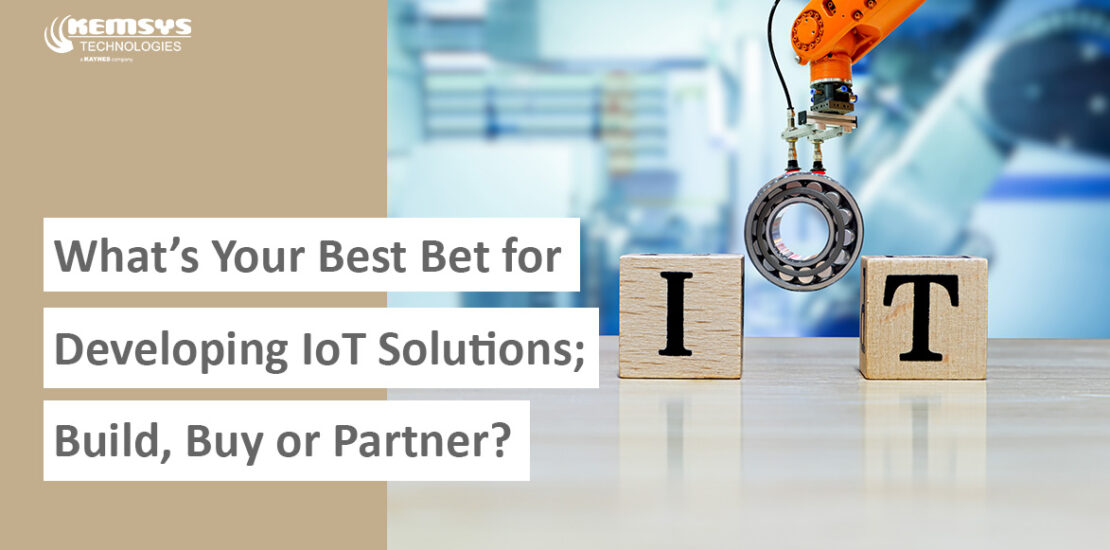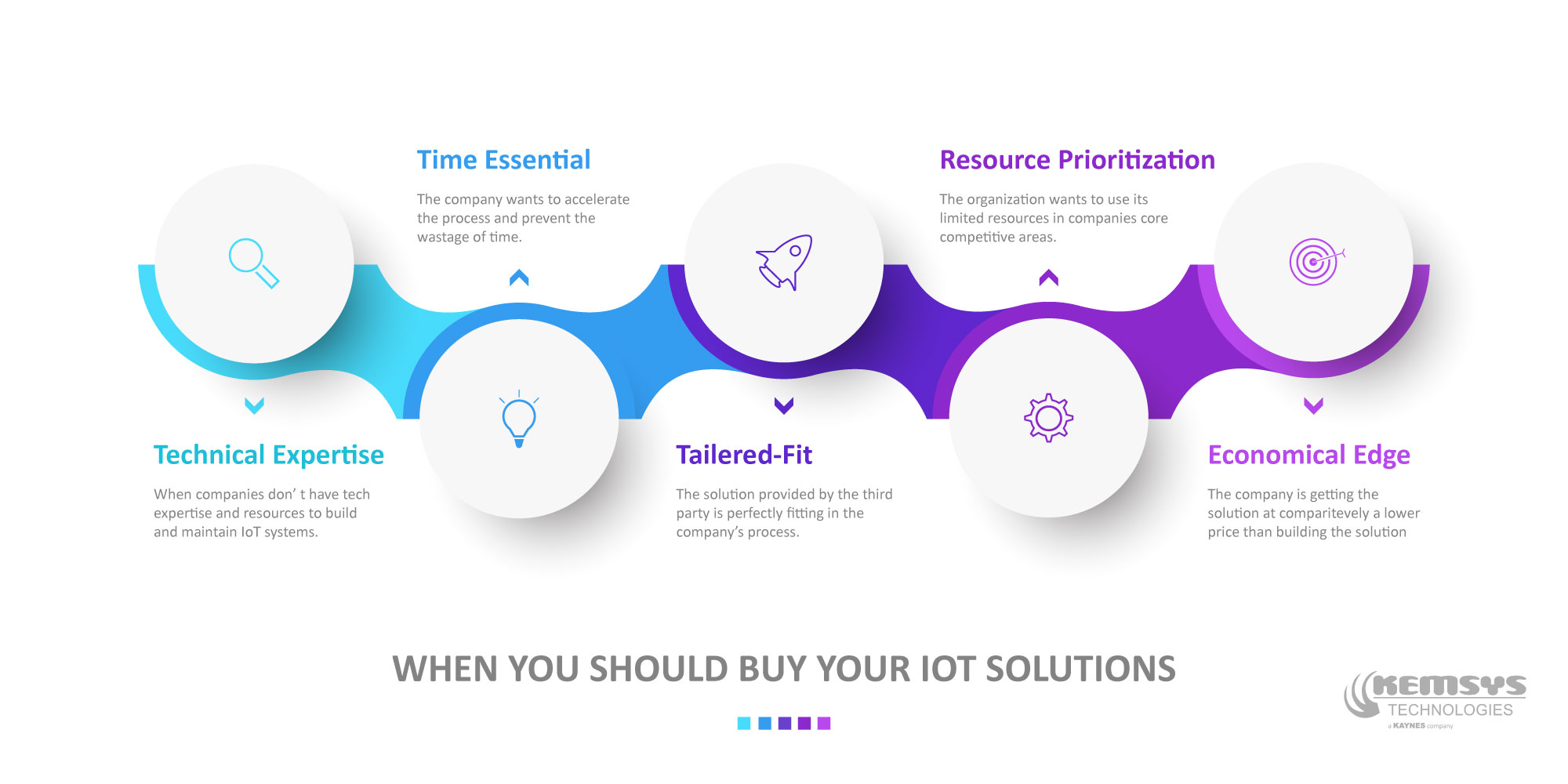Build, Buy, or Partner your IoT Solutions?
- September 2, 2021
- Posted by: Sanket Pathak
- Category: Internet of Things

The advancement of technology has made enterprises adopt the Internet Of Things (IoT) to embark on their digital transformation journey and make their products/solutions smarter. However, deciding which technology to opt for and whether to build, partner, or buy your IoT solutions has become a tough question for all these enterprises.
IoT is still at a nascent stage for many industries. With various building blocks (sensors, gateways, platform/application) and interoperability needs, it’s confusing to get started with IoT. Hence, through this blog, we will try to encapsulate the various aspects of the build, buy, and partner to market your IoT products and solutions so you zero down the best-suited option for you. Let’s explore!
Building IoT Solutions
The building aspect allows developing an IoT solution that is fully customized to your use case. Every business process has its requirements and IoT works by analyzing the insights of the process to achieve better efficiency. Building your own IoT solution is a favorable choice for businesses as they can develop a solution that ideally fits their business application.
However, the decision should only be taken if the organization has the needed expertise in the field. The process to build IoT solutions is complex and requires thorough knowledge of each building block and how those can be made to work in tandem. If you have the essential skill set (and time) to do so, building an IoT solution that can improve the performance of your machines/equipment/ processes is an excellent step to take.
Buying IoT Solutions
The buying methodology of the IoT solution focuses on procuring all or some components of the solution from a third party. The required technology/building blocks are acquired from a third party which includes buying the rights of technology/building blocks from them.
The benefit of leveraging this method is that the technology used is already licensed, tested, and functional. This eliminates waste of time and resource efficiency can be maximized with limited execution risk.
While using this approach, enterprises typically buy technology platforms or required hardware (sensors/gateways) from the vendor and further build their explicit solution components on top of that. However, this process has a significant disadvantage. As it is a ready-made solution, the company loses the ability to custom develop the hardware and software according to their needs. Also, this method isn’t agile and when required to make transitions as per the market needs, the model can miserably fail.
This approach can be considered when:
- Companies themselves aren’t tech-savvy enough to build and maintain IoT systems.
- The solution provided by the third party is perfectly fitting in the company’s process.
- The company is getting the solution at a lower price.
- The company wants to accelerate the process and prevent the wastage of time.
- The organization wants to use its limited resources in other areas.

How About Parterning with Experts?
Partnering with an expert consulting firm that understands and customizes the required building blocks and also maintains and manages them, is a popular choice these days. In this aspect of IoT, an organization, a thought leader in the industry segment but that isn’t fully capable of digitally transforming their industry segment, joins hands with expert firms so that they can jointly work together to build the right IoT solutions.
Using this approach, both the companies enter the market with each other’s support and develop IoT solutions that can help both of them grow. This methodology usually provides a faster time to market. However, the problem with this way is that it might add unnecessary integration and management complexity which results in limited loss of control for both parties.
Pros and Cons: IoT Build Vs. Buy Vs. Partner
Every process has its pros and cons. Similarly, whether you build, buy, or partner your own IoT solution, there will be certain positives and negatives in each of the processes. A few of them are given in the table below:
| Options | Pros | Cons |
| IoT Build |
|
|
| IoT Buy |
|
|
| IoT Partner |
|
|
What is the Best Option for Your Enterprise?
There are various quantitative and qualitative factors to consider when deciding to buy, build, or partner an IoT solution for your organization. Quantitative factors are essential to determine the estimated total costs of building the solution versus buying the solution.
Contrary, qualitative factors help the company to identify and reduce some of the decision-making risks. Let us explore more about them:
Quantitative Factors to Consider
There are many quantitative factors connected with technology and the cost of labor that can impact your decision. Some of the basic parameters worth considering are:
- Hardware
Hardware is an essential resource on which the IoT platform will run. In all build, partner, and buy cases, this is the cost that the company itself has to bear.
- Infrastructure
Infrastructure in this context refers to the cloud-based computation the company needs to run the IoT platform. If you are going with the buying option, you may have to pay a good amount of fee to the vendor for using their cloud services.
- SaaS
In an IoT system, there are a plethora of devices connected with a single platform. These devices deploy a number of applications and APIs. Also, they charge a fee for using their service and platform, which the user has to bear when buying an IoT solution.
- Labor
One also needs the support of human resources to run the IoT platform actively. The labor can be classified into two types: design and development labor and conceptualization and creation labor. Both play a significant part in the development of the solution. Building the IoT solution yourself will save you from these costs, else you have to bear these costs too.
Qualitative Factors to Consider
Numerous qualitative factors can have a material impact on the company’s IoT build, buy decision. Take a look at the given parameters:
Time-to-Market
It refers to the total amount of time taken by the enterprise to launch the solution. In the case of the building of an IoT platform, it is significantly high compared to the ready-made buying of the IoT solution.
KpiX, one of the industrial asset monitoring solutions developed by Kemsys allows OEMs to quickly deploy IoT solutions with custom tweaks and white labeling.
Customization Requirements
Any model that you deploy will need some level of customization. Hence, you should first analyze your requirements to check what is the level of customization your enterprise will require.
Compliance and Security
Meeting security requirements and regulatory compliances are essential and can impact the decision to buy, partner, or build your IoT platform.
Ongoing support
IoT solutions usually require ongoing support for their smooth functioning. There are several costs related to this task, and hence this consideration must not be ignored.
Management Considerations
Apart from the quantitative and qualitative factors, a few management considerations must be kept in mind while making the decision. Check every step from the strategy building, execution, to the actual transformation of the process in both scenarios. It will help you make an informed decision on which one is best for your requirements.
Final Thoughts
So should you opt for IoT Build, Buy, or Partner? Well, we have provided you with sufficient information about all three processes along with their positives and negatives. The best is to first consider your enterprise requirements thoroughly and then select the option which makes sense to you. Get in touch with our expert IoT team that can analyze your needs and assist you in getting the right IoT solution for your digital transformation process.

